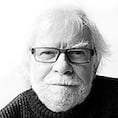Mention the idea of place in Irish poetry and what comes to mind is the bucolic, the pastoral, the rural: WB Yeats’s Sligo, Patrick Kavanagh’s Monaghan, Seamus Heaney’s Co Derry. The cityscape took some time to be admitted as a subject. The idealised Ireland was elsewhere, beyond the Pale – in the green pastures, on the hills and bogs, by the lakes and on the shores, especially our western shores.
But the city, especially Dublin, has well and truly entered the imaginative space of the poet, finding particular expression in the work of contemporary writers. Of course the city has been present, if perhaps randomly, since before the time of Jonathan Swift, but perhaps the mid 20th century publication of Austin Clarke's Ancient Lights marks the moment when urban consciousness began to assert its place in the tradition.
And it wasn't only Dublin-born poets like Clarke, Thomas Kinsella and Eavan Boland who took to this new territory. In an early poem Kavanagh tells us that he knew "nothing about cities". Yet after years living in Dublin the Monaghan poet was capable of creating a powerful sense of the city in his Canal Bank sonnets and in the evocative, haunting Raglan Road , a magnificent love poem and a homage to the place of its title that has the effect of making even those who have never been there feel as if they know it intimately.
Like Kavanagh, each of the many poets we have gathered here renders his or her distinctive sense of place. The anthology is one of multiple perspectives: in these poems are many Dublins, a city of different strokes for different poets. The mood music of the city that each poet hears and conveys is strikingly different from poet to poet, poem to poem.
After the American poet John Berryman arrived in the city in the 1960s, he wrote to his mother that he was “determined that Dublin shall be fascinating and I shall set out about time to prove it”. From its inner-city streets out to its suburban edges, Dublin’s fascinations have permeated the work of many poets. Among the more obvious examples are those who are almost synonymous with the city: Clarke, Kavanagh, Kinsella, Paula Meehan, Peter Sirr, Harry Clifton and Eavan Boland. These and other poets have between them charted the map that is Dublin in verse and, in doing so, universalised the local. All of them are a part of Dublin’s story “and its outcome / And ready to record its contradictions”, as Boland says in one poem.
In these poems and songs we are presented with a sense of some of those contradictions, but above all we have the city as muse, as the consecrated ground and sustenance of the imagination. This is not a collection devoted only to loving portraits or of poets in rapture to the places they behold. Louis MacNeice notes its “seedy elegance”, the “Grey stone, grey water / And grey brick upon grey brick”, but also “A dance of light in the Liffey”.
The river's "stinking tide" didn't go unnoticed by Jonathan Swift. Thomas Kinsella has called it "the umpteenth city of confusion" ( Phoenix Park ) but also acknowledged, when receiving his freedom of the city, that "Dublin gave many important things their first shape and content for me. I learned to look at the world through the rich reality of the inner city."
That rich reality is brought to life by poets born in the city, by those who came to live in it from other parts of our island and by outsiders who have merely passed through it. Here we have the city in which the “aspidistra grows dusty behind the window pane” and in which one poet sees “St Valentine’s stubborn heart come floating from Whitefriar Street” and another is aware that
A Million citizens worked, ate meals
Or dreamt a moment of Joyce.
The city that became a fascination for me was one shifting between the two halves of a century, from the era of Joyce into a modern age – a place that seemed malleable and that the imagination could seize and re-create. In retrospect I could say that the city took possession of me, and in poems I wrote later in adult life I sought to take possession of it.
The Kerryman Brendan Kennelly, for whom Dublin is settled ground and who knows its streets intimately, has said that to “stroll through Dublin is to stroll through history . . . more a stage than a city”.
What is evident among the poets who have located poems in the capital is how the city acts as a storehouse of personal and social memory. The evocative and associative power of place names – Fumbally Lane, Pigeon House, Blackpitts, Bully’s Acre – can exert a compelling spell. For many of us they are weighted with memory, like the “known landscape” that was to Tennyson “an old friend that continually talks to me of my own youth and half-forgotten things”.

















